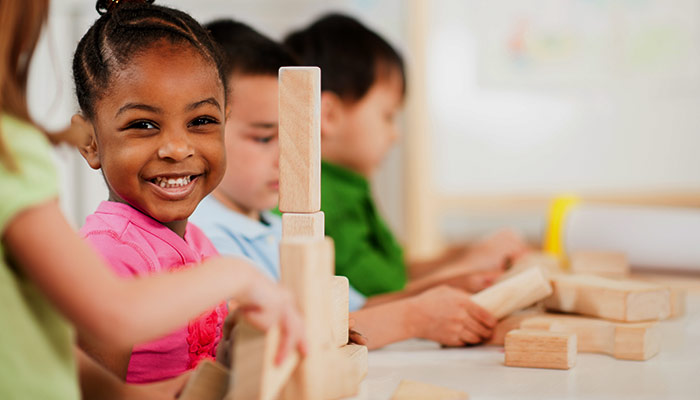While we believe that the books and resources recommended may be of value to you, keep in mind that these are suggestions only and you must do your own due diligence to determine whether the materials are appropriate and suitable for your use. PNC has no sponsorship or endorsement agreement with the authors or publishers of the materials listed.
TINKERING & MAKING

Building and Forces
Children will explore forces.

Lesson Objective
Children will tinker with a variety of simple building materials to explore how a force – gravity – and balance affect building and construction.
Science
What You'll Need
- Wooden and/or foam blocks
- Paper towel tubes
- Small cardboard boxes
- Recycled materials that lend themselves to building, such as plastic fruit baskets, clean plastic containers, cereal boxes, or cylindrical cardboard oatmeal containers
- Photographs or digital images of a variety of buildings and structures
What To Do
Note: This exploration can go on for several days, as long as children maintain interest (see Lesson Tips).
- Introduce building and construction during whole-group time by displaying images of different types of structures.
- Ask the children what they know about buildings (see Guiding Student Inquiry).
- Display the materials, and place them in an open space with plenty of room for building.
- Tinker with and explore the materials with the children. Ask them what they notice about the materials (see Guiding Student Inquiry).
- Allow children plenty of time for undirected play with the materials.
- Observe and offer guidance to children as they notice the differences in the materials; materials differ in weight, shape, and size. Ask questions such as “What might happen if you place this material here?”
- Ask children what happened when something that they were building fell over, why they think that happened, and what they could do to build it better the next time.
- Introduce new words such as force, gravity, and balance as you are discussing the children’s play with them (see Vocabulary).
- Gather children for a whole-group discussion about their experiences. Encourage children to discuss what they did with the materials, the challenges they faced, and how they solved those challenges.
Resources
Home School Resources
Home educators: use these printable lesson PDFs to teach this lesson to your home schoolers. They're available in English and Spanish.
Content Provided By
Common Core State Standards Initiative – These lessons are aligned with the Common Core State Standards ("CCSS"). The CCSS provide a consistent, clear understanding of the concepts and skills children are expected to learn and guide teachers to provide their students with opportunities to gain these important skills and foundational knowledge [1]. Visit the CCSS


